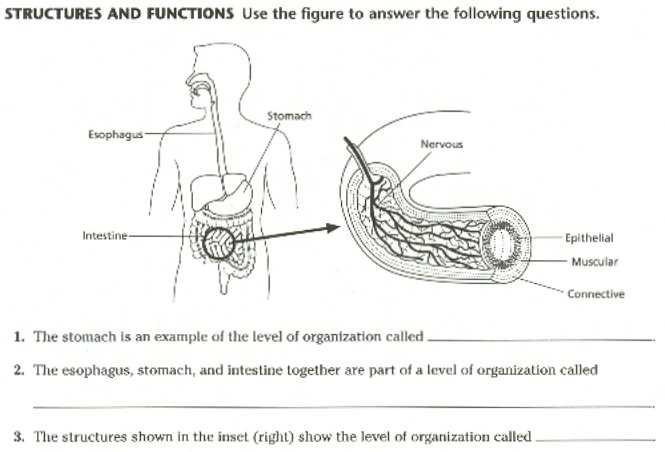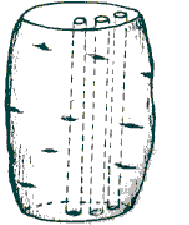
In 1908, G.H.Hardy and W. Weinberg independently suggested a scheme whereby evolution could be viewed as changes in frequency of alleles in a population of organisms. In this scheme, if A and a are alleles for a particular gene locus and each diploid individual has two such loci, then p can be designated as the frequency of the A allele and q as the frequency of the a allele. For example, in a population of 100 individuals ( each with two loci ) in which 40% of the alleles are A, p would be 0.40. The rest of the alleles would be ( 60%) would be a and q would be equal to 0.60. p + q = 1 These are referred to as allele frequencies. The frequency of the possible diploid combinations of these alleles ( AA, Aa, aa ) is expressed as p2 +2pq +q2 = 1.0. Hardy and Weinberg also argued that if 5 conditions are met, the population’s alleles and genotype frequencies will remain constant from generation to generation. These conditions are as follows:
- The breeding population is large. ( Reduces the problem of genetic drift.)
- Mating is random. ( Individual show no preference for a particular mating type.)
- There is no mutation of the alleles.
- No differential migration occurs. ( No immigration or emigration.)
- There is no selection. ( All genotypes have an equal chance of surviving and reproducing.)
The Hardy-Weinberg equation describes an existing situation. Of what value is such a rule? It provides a yardstick by which changes in allelic frequencies can be measured. If a population’s allelic frequencies change, it is undergoing evolution.
Estimating Allele Frequencies for a Specific Trait within a Sample Population:
Using the class as a sample population, the allele frequency of a gene controlling the ability to taste the chemical PTC (phenylthiocarbamide) could be estimated. A bitter taste reaction is evidence of the presence of a dominant allele in either a homozygous (AA) or heterozygous (Aa) condition. The inability to taste the PTC is dependent on the presence of the two recessive alleles (aa). Instead of using the PTC paper the trait for tongue rolling may be substituted. To estimate the frequency of the PTC -tasting allele in the population, one must find p. To find p, one must first determine q ( the frequency of the non tasting allele).
Procedure:
1. Using the PTC taste test paper, tear off a short strip and press it to your tongue tip. PTC tasters will sense a bitter taste.
2. A decimal number representing the frequency of tasters (p2+2pq) should be calculated by dividing the number of tasters in the class by the total number of students in the class. A decimal number representing the frequency of the non tasters (q2) can be obtained by dividing the number of non tasters by the total number of students. You should then record these numbers in Table 8.1.
3. Use the Hardy-Weinberg equation to determine the frequencies (p and q ) of the two alleles. The frequency q can be calculated by taking the square root of q2. Once q has been determined, p can be determined because 1-q=p. Record these values in Table 8.1 for the class and also calculate and record values of p and q for the North American population.
Table 8.1 Phenotypic Proportions of Tasters and Nontasters and Frequencies of the Determining Alleles
| #= | %= | #= | %= | |||
Topics for Discussion:
1. What is the percentage of heterozygous tasters (2pq) in your class? ______________________.
2. What percentage of the North American population is heterozygous for the taster allele? _____________
Case Studies:
Case 1 ( Test of an Ideal Hardy-Weinberg Community)
The entire class will represent a breeding population, so find a large open space for its simulation. In order to ensure random mating, choose another student at random. In this simulation, we will assume that gender and genotype are irrelevant to mate selection.
The class will simulate a population of randomly mating heterozygous individuals with an initial gene frequency of 0.5 for the dominant allele A and the recessive allele a and genotype frequencies of 0.25AA, 0.50Aa, and 0.25aa. Record this on the Data page at the end of the lab. Each member of the class will receive four cards. Two cards will have A and two cards will have a. The four cars represent the products of meiosis. Each “parent” will contribute a haploid set of chromosomes to the next generation.
Procedure:
1. Turn the four cards over so the letters are not showing, shuffle them, and take the card on top to contribute to the production of the first offspring. Your partner should do the same. Put the cards together. The two cards represent the alleles of the first offspring. One of you should record the genotype of this offspring in the Case 1 section at the end of the lab. Each student pair must produce two offspring, so all four cards must be reshuffled and the process repeated to produce a second offspring.
2. The other partner should then record the genotype of the second offspring in the Case 1 section at the end of the lab. Using the genotypes produced from the matings, you and your partner will mate again using the genotypes of the two offspring. That is , student 1 assumes the genotype of the first offspring, and student 2 assumes the genotype of the second offspring.
3. Each student should obtain, if necessary, new cards representing their alleles in his or her respective gametes after the process of meiosis. For example, student 1 becomes the genotype Aa and obtains cards A,A,a,a; student 2 becomes aa and obtains cards,a,a,a,a. Each participant should randomly seek out another person with whom to mate in order to produce offspring of the next generation. You should follow the same mating procedure as for the first generation, being sure you record your new genotype after each generation in the Case 1 section. Class data should be collected after each generation for five generations. At the end of each generation, remember to record the genotype that you have assumed. Your teacher will collect class data after each generation by asking you to raise your hand to report your genotype.
Allele frequency: The allele frequencies, p and q, should be calculated for the population after five generations of simulated random mating.
Number of A alleles present at the fifth generation
Number of offspring with genotype AA _____________ X 2= _______________ A alleles
Number of offspring with genotype Aa _____________ X 1= ________________A alleles
Total = ____________ A alleles
| p = | Total number of A alleles | = | ||
| Total number of alleles in the population | ||||
In this case, the total number of alleles in the population is equal to the number of students in the class X 2.
Number of a alleles present at the fifth generation
Number of offspring with genotype aa _____________ X 2= _______________ a alleles
Number of offspring with genotype Aa _____________ X 1= ________________A alleles
Total = ____________ a alleles
| = | ||||
| Total number of alleles in the population | ||||
1. What does the Hardy-Weinberg equation predict for the new p and q?.
_____________________________________________________________________
_____________________________________________________________________
2. Do the results you obtained in this simulation agree? __________ If not, why not?
_____________________________________________________________________
_____________________________________________________________________
3. What major assumption(s) were not strictly followed in this simulation?
_____________________________________________________________________
_____________________________________________________________________
Case 2 ( Selection )
In this case you will modify the simulation to make it more realistic. in the natural environment , not all genotypes have the same rate of survival; that is, the environment might favor some genotypes while selecting against others. An example is the human condition sickle-celled anemia. It is a condition caused by a mutation on one allele, in which a homozygous recessive does not survive to reproduce. For this simulation you will assume that the homozygous recessive individuals never survive. Heterozygous and homozygous dominant individuals always survive.
The procedure is similar to that for Case 1. Start again with your initial genotype, and produce your “offspring” as in Case 1. This time, However, there is one important difference. Every time your offspring is aa it does not reproduce. Since we want to maintain a constant population size, the same two parents must try again until they produce two surviving offspring. You may need to get new allele cards from the pool.
Proceed through five generations, selecting against the homozygous offspring 100% of the time. Then add up the genotype frequencies that exist in the population and calculate the new p and q frequencies in the same way as it was done in Case 1.
Number of A alleles present at the fifth generation
Number of offspring with genotype AA _____________ X 2= _______________ A alleles
Number of offspring with genotype Aa _____________ X 1= ________________A alleles
Total = ____________ A alleles
| p = | Total number of A alleles | = | ||
| Total number of alleles in the population | ||||
In this case, the total number of alleles in the population is equal to the number of students in the class X 2.
Number of a alleles present at the fifth generation
Number of offspring with genotype aa _____________ X 2= _______________ a alleles
Number of offspring with genotype Aa _____________ X 1= ________________A alleles
Total = ____________ a alleles
| = | ||||
| Total number of alleles in the population | ||||
1. How do the new frequencies of p and q compare to the initial frequencies in Case 1?
_____________________________________________________________________
_____________________________________________________________________
2. How has the allelic frequency of the population changed?
_____________________________________________________________________
_____________________________________________________________________
3. Predict what would happen to the frequencies of p and q if you simulated another 5 generations.
_____________________________________________________________________
_____________________________________________________________________
4. In a large population, would it be possible to completely eliminate a deleterious recessive allele? Explain.
_____________________________________________________________________
_____________________________________________________________________
_____________________________________________________________________
_____________________________________________________________________
Hardy-Weinberg Problems
1. In Drosophila, the allele for normal length wings is dominant over the allele for vestigial wings. In a population of 1,000 individuals, 360 show the recessive phenotype. How many individuals would you expect to be homozygous dominant and heterozygous for this trait?
2. The allele for the ability to roll one’s tongue is dominant over the allele for the lack of this ability. In a population of 500 individuals, 25% show the recessive phenotype. How many individuals would you expect to be homozygous dominant and heterozygous for this trait?
3. The allele for the hair pattern called “widow’s peak” is dominant over the allele for no “widow’s peak.” In a population of 1,000 individuals, 510 show the dominant phenotype. How many individuals would you expect of each of the possible three genotypes for this trait?
4. In a certain population, the dominant phenotype of a certain trait occurs 91 % of the time. What is the frequency of the dominant allele?
Data Page:
Case 1 ( Hardy-Weinberg Equilibrium )
Initial Class Frequencies:
AA ________ Aa________ aa_________
My initial genotype :_______________
F1 Genotype ______
F2 Genotype ______
F3 Genotype ______
F4 Genotype ______
F5 Genotype ______
Final Class Frequencies:
AA ________ Aa________ aa_________
p _________ q __________
Case 2 ( Selection )
Initial Class Frequencies:
AA ________ Aa________ aa_________
My initial genotype :_______________
F1 Genotype ______
F2 Genotype ______
F3 Genotype ______
F4 Genotype ______
F5 Genotype ______
Final Class Frequencies:
AA ________ Aa________ aa_________
p _________ q __________






